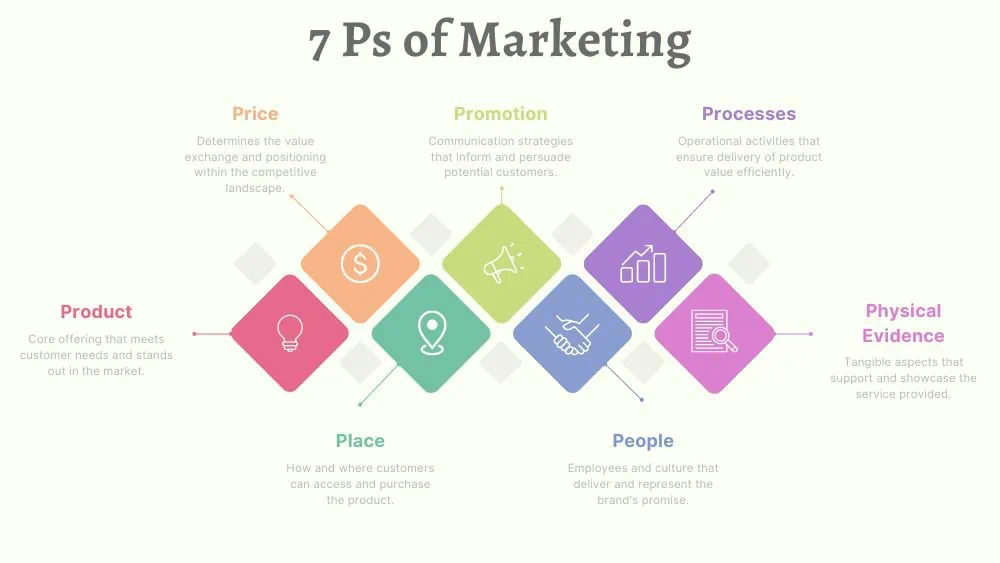The concept of the marketing mix is foundational in both academic and practical marketing contexts, serving as a cornerstone for crafting successful marketing strategies.
This managerial approach outlines how marketers can manipulate key elements to effectively market their product or service to their target audience.
Originating from the seminal work of marketing professor E. Jerome McCarthy, the marketing mix is often encapsulated by the four Ps of marketing: Product, Price, Place, and Promotion.
These components help marketers to ensure they’re offering the right product, at the right price, in the right place, and with the right promotion strategies to meet their basic marketing objectives and satisfy their target market.
It was further popularized and implemented by the book “Basic Marketing: A Managerial Approach”, which was co-written by McCarthy.
Usually, the marketing mix refers to the original 4 Ps of marketing but the extended 7 Ps of marketing can be a valuable tool for business executives looking to improve their online marketing.
The Original 4 Ps of the Marketing Mix
The four Ps framework provides a comprehensive model that helps marketers to devise successful products and strategies that resonate with their target customers. Each ‘P’ represents a different aspect of the marketing strategy. Here are the four key elements:
Product
This element focuses on the goods or services offered by a business. A successful marketing strategy ensures that the product meets the needs and expectations of the target market, from its design and features to quality and branding.
Price
Pricing strategies are crucial in determining how a product is perceived in the market. This includes not only the base price but also product promotion, financing options, and payment terms that can make the product more attractive to potential customers. A well-thought-out product pricing strategy within a marketing plan can make or break a new business.
Place
Also known as distribution, place involves making the product available to the target consumers through the right distribution channels. Whether it’s a physical location, an online store, or a sales force, ensuring the product is accessible is key to its success.
Promotion
This encompasses all the ways a business communicates about its product or service to the target audience, including advertising approaches, public relations, social media marketing, email marketing, and more. Effective promotion strategies raise awareness and drive sales by reaching the right audience with compelling marketing messages.
Expanding the Mix: The Additional 3 Ps
Acknowledging the evolving landscape of the marketing world, especially with the rise of service-oriented businesses and the digital age, the already good marketing mix was expanded to include three additional Ps: People, Processes, and Physical Evidence.
People
Reflects the importance of everyone involved in the production and delivery of the product or service, from employees to customers. The human element in marketing emphasizes the role of customer service and the overall customer experience.
Processes
These are the systems and procedures through which products or services are delivered. Efficient processes can enhance customer satisfaction and operational efficiency.
Physical Evidence
This includes all the tangible aspects that prove the existence and quality of the service, like physical products, packaging, or even the physical location of a brick-and-mortar store. It helps in building trust and credibility among potential customers.
Understanding the 4 Ps: In-Depth Exploration
The four Ps offer a framework through which businesses can analyze and plan their marketing strategies, ensuring that they address key factors essential for market success.
Product Strategy
Businesses must focus on understanding their customers’ needs and developing products that provide superior value. This might involve continuous innovation, attention to product life cycle, and maintaining quality.
Price Strategy
Finding the right price requires analyzing competitors’ prices, understanding supply costs, and considering the perceived value to the customer. Pricing models may vary, from premium pricing to seasonal discounts, to match the business goals and market expectations.
Place Strategy
Selecting the right distribution channels is crucial to ensure that the product reaches its intended market. This could range from selecting the most effective online platforms to establishing a presence in local stores.
Promotion Strategy
A comprehensive promotion plan uses various channels and techniques, like digital marketing, television commercials, and public relations, to communicate with the target audience and drive sales.
Delving into the Extended 7 Ps
The extended 7 Ps model provides a more comprehensive view of the marketing mix, especially useful for services marketing where direct customer interaction and the intangible nature of the offering play critical roles. Let’s explore these additional Ps:
People
Central to delivering an exceptional customer experience, the ‘People’ element recognizes the value of human interaction in marketing.
Employees’ attitudes, skills, and service quality directly impact customer satisfaction and loyalty. Training programs, employee engagement strategies, and a strong organizational culture are pivotal in fostering a team that can successfully market and deliver the company’s offerings.
Processes
This component emphasizes the importance of streamlined and customer-friendly processes in delivering a product or service.
From online purchasing systems to the sales force’s response times, efficient processes ensure customer satisfaction and can significantly enhance operational efficiency.
Businesses need to continually assess and refine their processes for continuous improvement, ensuring they align with customer expectations and business objectives.
Physical Evidence
In a world where services cannot always be seen or touched before purchase, physical evidence becomes a crucial factor in building trust.
This can include everything from the design of a website, and the ambiance of a brick-and-mortar store, to the tangible aspects of the service, like packaging or even documentation.
Providing customers with solid, reassuring physical evidence can be a decisive factor in the purchasing process.
Application of the 4 Ps in Digital Marketing
In the digital age, applying the traditional 4 Ps requires a fresh perspective to effectively reach and engage with the modern, connected consumer:
- Product in Digital: The digital platform offers an opportunity for businesses to innovate in their product offerings. This includes adding digital features or services, enhancing product accessibility through online channels, and leveraging technologies to improve product functionality and customer experience.
- Price in Digital: Digital channels provide new ways to approach pricing strategies. Dynamic pricing, online discounts, and subscription models are examples of how businesses can adapt their pricing strategies for the digital marketplace. Additionally, transparency and ease of price comparison online push businesses to be more competitive and customer-focused in their pricing.
- Place in Digital: The ‘Place’ component shifts significantly in the context of digital marketing. It involves choosing the right online platforms and marketplaces for product distribution. SEO strategies, social media presence, and e-commerce platforms become critical distribution channels that can expand a product’s reach beyond traditional geographic limitations.
- Promotion in Digital: Digital channels revolutionize how businesses promote their products. Content marketing, social media marketing, email marketing, and online advertising approaches enable businesses to engage with their target audience more interactively and personally. The focus shifts towards creating valuable, relevant content that attracts and retains a clearly defined audience, driving profitable customer action.
The integration of digital considerations into the 4 Ps underscores the need for businesses to adapt and evolve their marketing strategies to meet the demands of an increasingly digital marketplace. Successful modern marketers understand that the digital transformation of the 4 Ps is not just about transferring traditional strategies online but reimagining how to effectively market in a digital world.
Challenges and Critiques of the Marketing Mix Model
While the Marketing Mix, encompassing both the original 4 Ps and the extended 7 Ps, serves as a foundational framework in marketing theory and practice, it has not been without its challenges and critiques:
Adaptability to the Service Sector
One significant critique is the model’s initial focus on tangible products, which led to the later extension to the 7 Ps to better accommodate the complexities of the service sector. Critics argue that even with this extension, the model may still fall short in addressing the full scope of modern service marketing intricacies.
Dynamic Market Conditions
The rapid pace of change in consumer behavior, technology, and global markets challenges the static nature of the 4 Ps model. Critics contend that the model may not fully capture the fluidity required in today’s digital marketing landscape, where consumer preferences and digital platforms evolve swiftly.
Overemphasis on Transactional Relationships
The traditional Marketing Mix is often seen as focusing too heavily on transactional exchanges between businesses and consumers. Modern marketing perspectives advocate for a more relationship-oriented approach, emphasizing long-term engagement and loyalty over single transactions.
Integration with Digital Marketing
As digital marketing becomes increasingly predominant, there’s a growing need for marketing frameworks that inherently integrate digital channels and consumer online behavior. Critics suggest that while the Marketing Mix can be adapted for digital marketing, it doesn’t inherently account for the nuances of online consumer engagement and the digital customer journey.
The Future of the Marketing Mix in Strategic Planning
Despite these challenges, the Marketing Mix continues to evolve, reflecting changes in consumer behavior, technological advancements, and the broader economic environment.
Looking forward, the model’s adaptability and foundational nature suggest it will remain a key component of marketing strategy, albeit with necessary adaptations:
- Incorporation of Digital and Social Media Elements: Future iterations of the Marketing Mix are likely to include elements specifically tailored to digital and social media marketing, acknowledging these platforms’ critical role in modern marketing strategies.
- Greater Emphasis on Customer Experience and Engagement: As businesses increasingly focus on building long-term relationships with their customers, future models of the Marketing Mix will likely place a greater emphasis on customer experience, engagement, and loyalty.
- Integration with Data Analytics: The ability to collect and analyze vast amounts of consumer data offers unprecedented insights into customer preferences and behavior. The Marketing Mix of the future will likely incorporate data analytics as a core component, allowing for more targeted, personalized marketing strategies.
- Sustainability and Ethical Marketing: With growing consumer concern for environmental and social issues, future developments in the Marketing Mix will need to reflect businesses’ commitment to sustainability and ethical practices, aligning marketing strategies with broader societal values.
Conclusion
The exploration of the Marketing Mix, from its foundational 4 Ps to the expanded 7 Ps, reveals a dynamic and enduring framework that has significantly shaped marketing strategy over decades.
While the model originated in a vastly different market landscape, its core principles have proven adaptable, guiding marketers through the evolution of consumer markets, the digital revolution, and the shift towards service-oriented economies.
Despite facing critiques for its perceived rigidity and product-focused origins, the Marketing Mix has evolved, reflecting the nuanced demands of service marketing, the imperatives of digital engagement, and the increasing importance of building lasting customer relationships.
The addition of People, Processes, and Physical Evidence to the original mix underscores a broader understanding of what it takes to successfully market in today’s complex environment.
As we look to the future, it’s clear that the Marketing Mix will continue to serve as a foundational tool for marketers, albeit one that must be continually adapted and expanded to meet new challenges.
The integration of digital strategies, an emphasis on customer experience, and the leveraging of data analytics are just a few areas where the Marketing Mix is set to evolve, ensuring its relevance and utility for future generations of marketers.
Furthermore, the growing emphasis on sustainability and ethical considerations suggests that future iterations of the Marketing Mix will need to incorporate these values into strategic planning. This evolution will not only reflect changing consumer priorities but also contribute to a more socially responsible marketing practice.
In conclusion, the Marketing Mix, with its 4 Ps and 7 Ps, remains a critical element of marketing understanding, offering a structured approach to crafting effective marketing strategies.
As marketers navigate the complexities of the modern business landscape, the Marketing Mix provides a lens through which to view strategic decisions, ensuring that efforts are balanced across product development, pricing strategies, distribution channels, and promotional activities.
Its continued adaptation and application across diverse sectors and in digital contexts underscore its enduring value as a strategic addition to the best marketing tools.








0 Comments